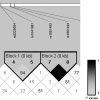Footprints of genetic susceptibility to pulmonary tuberculosis: cytokine gene variants in north Indians
- PMID: 22771610
- PMCID: PMC3401711
Footprints of genetic susceptibility to pulmonary tuberculosis: cytokine gene variants in north Indians
Abstract
Background & objectives: Tuberculosis is (TB) responsible for high morbidity and mortality worldwide. Cytokines play a major role in defense against Mycobacterium tuberculosis infection. Polymorphisms in the genes encoding the various pro- and anti-inflammatory cytokines have been associated with tuberculosis susceptibility. In this study we examined association of 25 sequence polymorphisms in six candidate cytokine genes namely IFNG, TNFB, IL4, IL1RA, IL1B and IL12 and their related haplotypes with risk of developing pulmonary tuberculosis (PTB) among north Indians.
Methods: Pulmonary TB (n=110) patients and 215 healthy controls (HC) from north India were genotyped. Purified multiplex PCR products were subjected to mass spectrometry using Sequenom MassARRAY platform to generate the genotypes in a population-based case-control study.
Results: Using multiple corrections, significant overall risk against PTB was observed at seven loci which included variants in IFNG at rs1861493 and rs1861494; IL1RA at rs4252019, IL4 variant rs2070874, IL12 variants rs3212220, rs2853694 and TNFB variant rs1041981. Analysis of gene structure revealed two haplotype blocks formed by IFNG variants rs1861493 and rs1861494. The TA haplotype was significantly over-represented (P=0.011) in the cases showing a two-fold risk in the current population (Odds ratio=1.59 CI=1.101 to 2.297) and TNFB variants at rs2229094 and rs1041981 contributed to two haplotypes which were in strong linkage disequilibrium (LD) with AT haplotype showing a three-fold risk (P=0.0011, Odds ratio=3, CI=0.1939 to 0.7445) of developing PTB in north Indians.
Interpretation & conclusions: Our study showed six novel associations of cytokine gene variants with susceptibility to PTB in north Indians. Variants of IFNG and TNFB emerged as factors imposing a significant risk of developing PTB in north Indians apart from risk indicated by IL1RA, IL4 and IL12.
Figures
Similar articles
-
Comparative Genetic Association Analysis of Human Genetic Susceptibility to Pulmonary and Lymph Node Tuberculosis.Genes (Basel). 2023 Jan 13;14(1):207. doi: 10.3390/genes14010207. Genes (Basel). 2023. PMID: 36672948 Free PMC article.
-
Differential serum cytokine levels are associated with cytokine gene polymorphisms in north Indians with active pulmonary tuberculosis.Infect Genet Evol. 2011 Jul;11(5):1015-22. doi: 10.1016/j.meegid.2011.03.017. Epub 2011 Apr 1. Infect Genet Evol. 2011. PMID: 21463712
-
Genetic association study suggests a role for SP110 variants in lymph node tuberculosis but not pulmonary tuberculosis in north Indians.Hum Immunol. 2011 Jul;72(7):576-80. doi: 10.1016/j.humimm.2011.03.014. Epub 2011 Apr 20. Hum Immunol. 2011. PMID: 21536091
-
Association between the mannose-binding lectin (MBL)-2 gene variants and serum MBL with pulmonary tuberculosis: An update meta-analysis and systematic review.Microb Pathog. 2019 Jul;132:374-380. doi: 10.1016/j.micpath.2019.04.023. Epub 2019 Apr 15. Microb Pathog. 2019. PMID: 30999018
-
Advances in cytokine gene polymorphisms in tuberculosis.mSphere. 2025 Apr 29;10(4):e0094424. doi: 10.1128/msphere.00944-24. Epub 2025 Mar 31. mSphere. 2025. PMID: 40162798 Free PMC article. Review.
Cited by
-
Comparative Genetic Association Analysis of Human Genetic Susceptibility to Pulmonary and Lymph Node Tuberculosis.Genes (Basel). 2023 Jan 13;14(1):207. doi: 10.3390/genes14010207. Genes (Basel). 2023. PMID: 36672948 Free PMC article.
-
Association of IFNGR1 and IFNG genetic polymorphisms with the risk for pulmonary tuberculosis in the Chinese Tibetan population.Oncotarget. 2017 Sep 30;8(58):98417-98425. doi: 10.18632/oncotarget.21413. eCollection 2017 Nov 17. Oncotarget. 2017. PMID: 29228700 Free PMC article.
-
Association of IL4, IL6, and IL10 polymorphisms with pulmonary tuberculosis in a Tibetan Chinese population.Oncotarget. 2018 Jan 6;9(23):16418-16426. doi: 10.18632/oncotarget.23995. eCollection 2018 Mar 27. Oncotarget. 2018. PMID: 29662655 Free PMC article.
-
The IFNG rs1861494 Single Nucleotide Polymorphism Is Associated with Protection against Tuberculosis Disease in Argentina.Genes (Basel). 2018 Jan 22;9(1):46. doi: 10.3390/genes9010046. Genes (Basel). 2018. PMID: 29361774 Free PMC article.
-
Effect of Interferon-γ Polymorphisms on Ankylosing Spondylitis: A Case-Control Study.Med Sci Monit. 2017 Aug 26;23:4126-4131. doi: 10.12659/msm.902822. Med Sci Monit. 2017. PMID: 28843049 Free PMC article.
References
-
- Raviglione MC, Snider DE, Jr, Kochi A. Global epidemiology of tuberculosis: morbidity and mortality of a worldwide epidemic. JAMA. 1995;273:220–6. - PubMed
-
- Stead WW, Senner JW, Reddick WT, Lofgren JP. Racial differences in susceptibility to infection by Mycobacterium tuberculosis. N Engl J Med. 1990;322:422–7. - PubMed
-
- Bellamy RJ, Hill AV. Host genetic susceptibility to human tuberculosis. Novartis Found Symp. 1998;217:3–13. - PubMed
-
- Newport MJ, Huxley CM, Huston S, Hawrylowicz CM, Oostra BA, Williamson R, et al. A mutation in the interferon- γ-receptor gene and susceptibility to mycobacterial infection. N Engl J Med. 1996;335:1941–5. - PubMed
-
- Altare F, Durandy A, Lammas D, Emile JF, Lamhamedi S, Le Deist F, et al. Impairment of mycobacterial immunity in human interleukin-12 receptor deficiency. Science. 1998;280:1432–5. - PubMed
Publication types
MeSH terms
Substances
LinkOut - more resources
Full Text Sources
Research Materials

